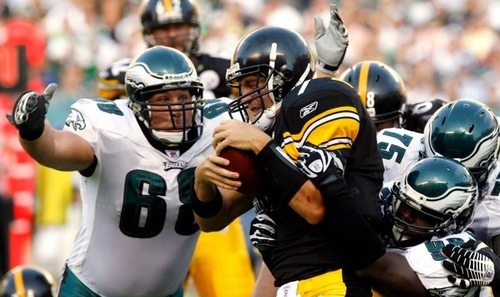
One of the biggest stories of the offseason (second only to the reason I started this blog) has been the complete retooling of the Eagles’ defensive line.
While the Eagles still blitzed a lot with new Defensive Coordinator Sean McDermott, the coaches clearly wanted better production from the front four:
“It would be nice if we’re able to get pressure from just rushing four and not [have to] rely on the blitz as we had to last year to some extent,” McDermott said. “When you can get pressure from your front four, that alleviates a lot of your problems.”
But was the front four really the problem? Looking at PFF’s defensive stats from the last two years, we can see how effective various parts of the pass rush were from the late Jim Johnson in 2008 to McDermott in 2009. The chart below shows the change in percent of total rushes and negatve plays (Sacks, Hits, Pressues, Batted Passes) made by each unit.
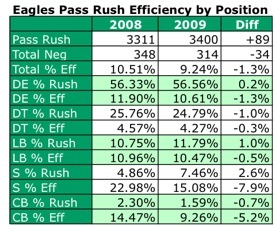
In case the chart isn’t completely intuitive, “DE % Rush” is the percent of total “Pass Rushes” by defensive ends (including the DEs that move inside on passing downs). “DE % Eff” is just the negative plays caused by this group, divided by their number of rushes. Then there’s the year-over-year difference.
As we’ve talked about on multiple occasions, the pass rush from defensive tackles is basically non-existant. Although guys like Bunkley, Patterson, Laws, and Dixon were in the game on more than one quarter of pass plays, they caused negative plays for the offense less than five percent of the time. That’s the most obvious sign yet that the Eagles are getting no pressure from those big fellas.
The linebackers, despite the drastic injuries, seem to have come out pretty much even on blitz pressure. The defensive backs definitely were less effective — but they account for only seven percent of all pass rushes. Still, perhaps because their blitzing was so infrequent, it was more effective than anything else.
So that brings us back to the defensive ends, the guys who are being paid pretty much exclusively to get after the quarterback. How’d they do? Pretty much the same overall from 2008. There was a drop by a little more than a percentage point. This is a much bigger portion of the total rushes, so one percent means a lot more, but it still doesn’t tell me that the Eagles got significantly worse all of sudden along the front line.
What if we compare by player? Here’s 2008 and 2009, for every player who rushed the passer at least 20 times (“Per Game” stats are based on ~62 offensive plays, all passes).
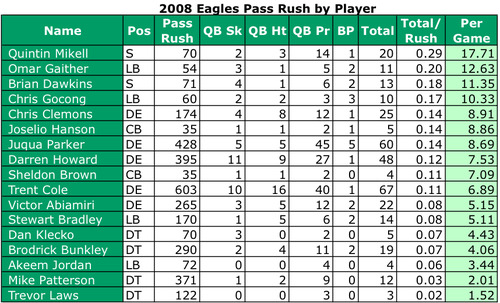
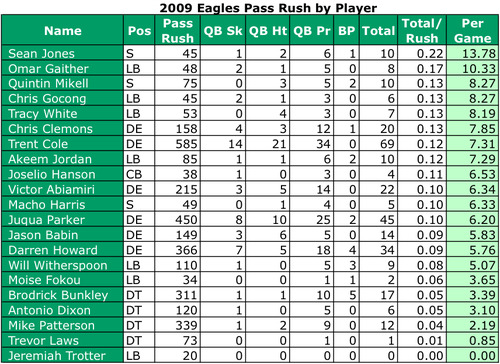
All of the defensive ends outside of Trent Cole and Victor Abiamiri declined from 2008 to 2009. And considering none are really up-and-coming youngsters, it probably was a good idea to bring in some fresh blood.
Other interesting things: Sheldon Brown went from 35 blitzes under Jim Johnson to a mere five with McDermott. A healthy Joselio Hanson looks like his still and effective blitzer from the slot. Surprising no one, Asante Samuel has only blitzed six times in in the last two seasons.
Omar Gaither is a really effective blitzer. Too bad his days in Philly seem numbered. And here’s yet more evidence that Chris Gocong probably should not have been stuck at SAM linebacker.
I really kind of like this “Negative Plays Per Rush” stat. It might be interesting to compare various players, such as Trent Cole, to others around the NFL at their positions…
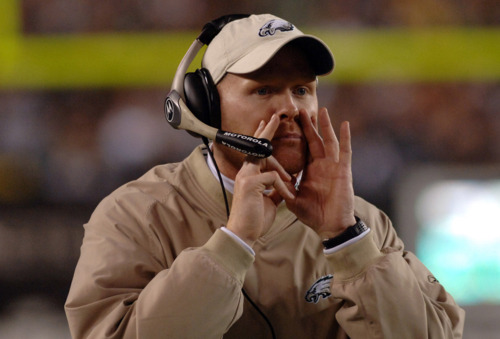


 First of all, let me just throw up the numbers for all of last year’s blitzing on the right. Overall, McDermott seems to have brought a few more blitzers on third down than JJ, but other than that the defensive playcalling was fairly consistent from 2008.
First of all, let me just throw up the numbers for all of last year’s blitzing on the right. Overall, McDermott seems to have brought a few more blitzers on third down than JJ, but other than that the defensive playcalling was fairly consistent from 2008. On top you can see the differences in percentage from the season average for the first game. In this one the Eagles blitzed constantly, sending five, six, and seven guys after the quarterback way more than average. In fact, only on first down did McDermott blitz less than half the time.
On top you can see the differences in percentage from the season average for the first game. In this one the Eagles blitzed constantly, sending five, six, and seven guys after the quarterback way more than average. In fact, only on first down did McDermott blitz less than half the time. Of course, we know that this change didn’t work too well. Which leads us to the final charts of the evening (at right), which shows the effectiveness of the two game plans. I’m not sure that this can be extrapolated out for more than this particular case, but here the results suggest one thing.
Of course, we know that this change didn’t work too well. Which leads us to the final charts of the evening (at right), which shows the effectiveness of the two game plans. I’m not sure that this can be extrapolated out for more than this particular case, but here the results suggest one thing.


